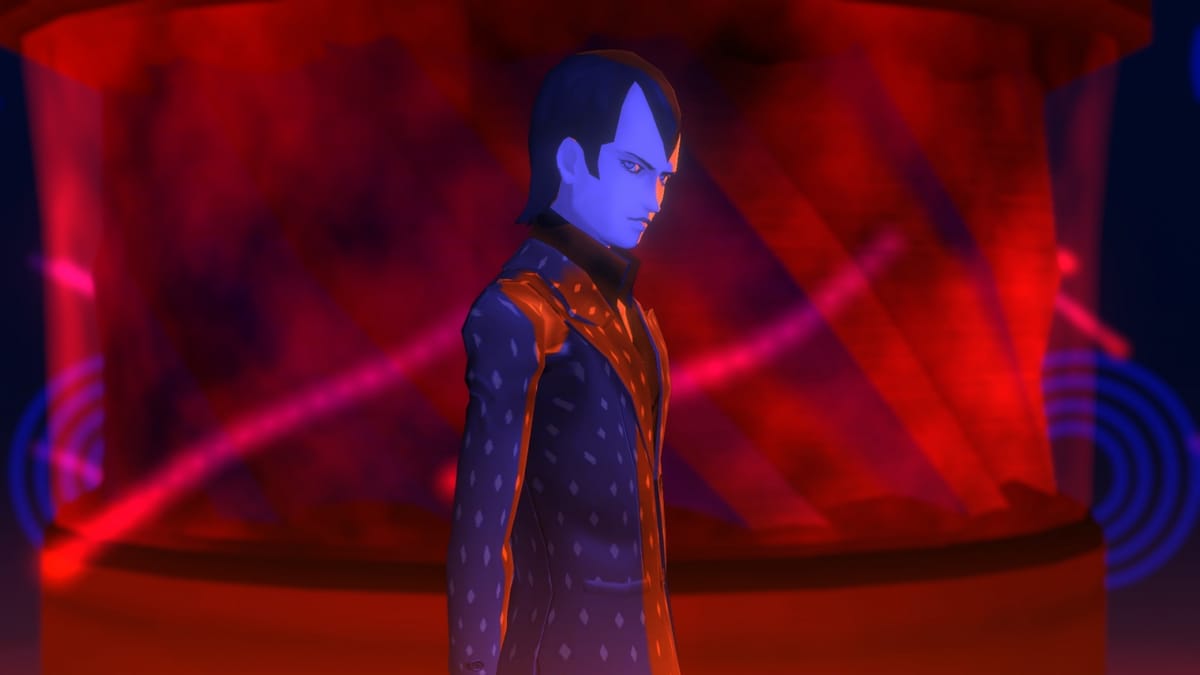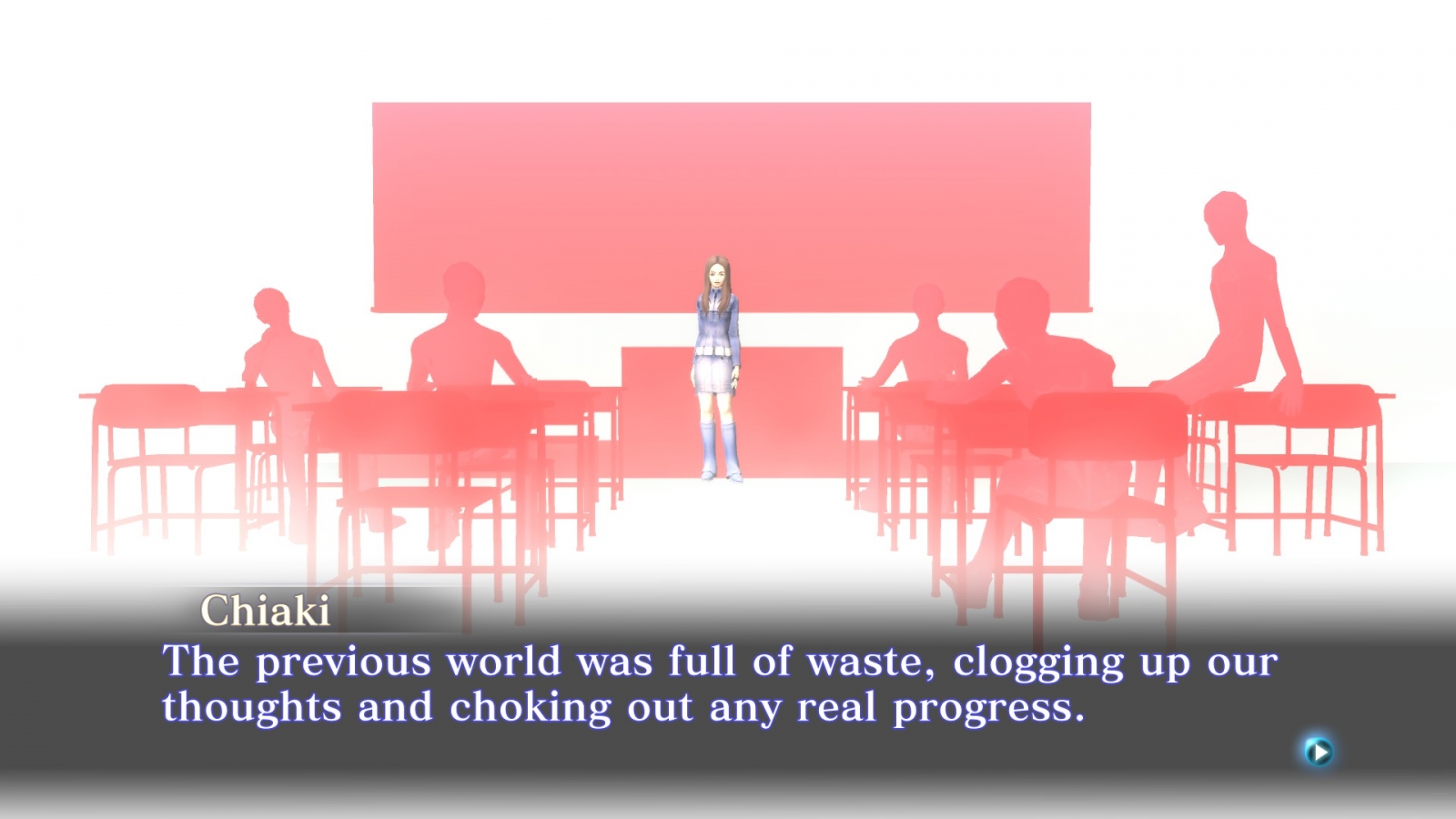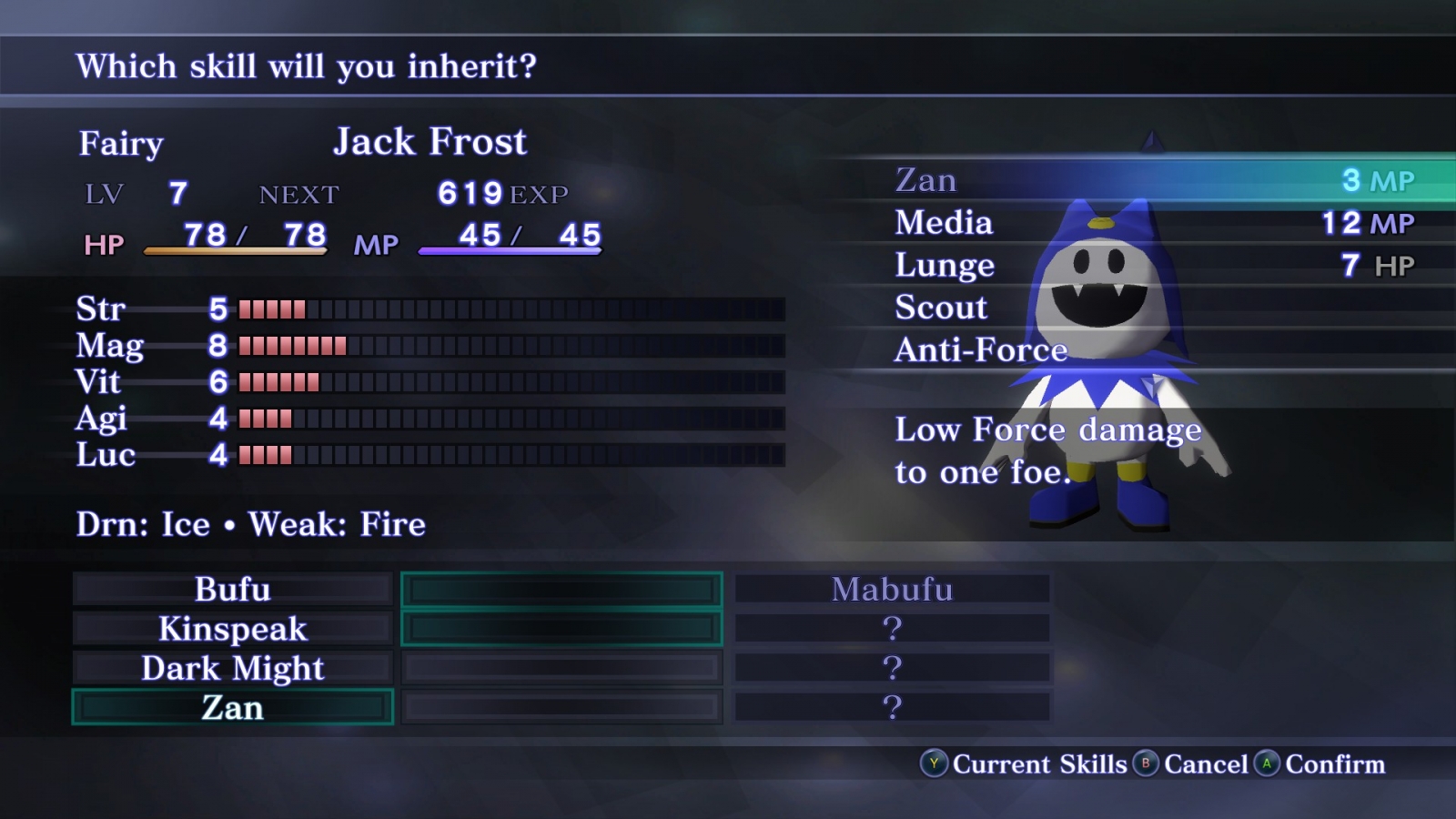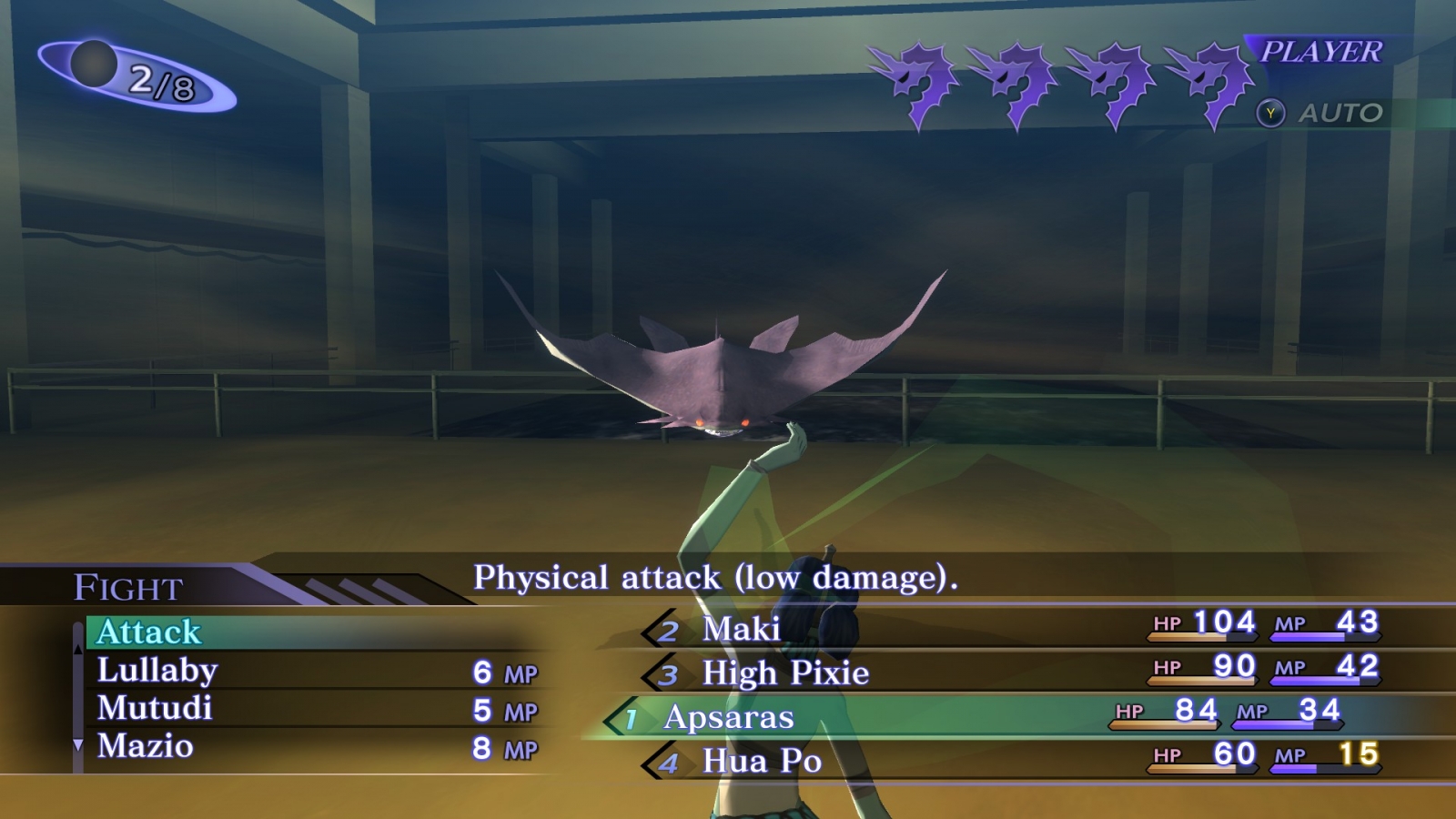
The Vortex World is one of chaos and hardship. It serves as a transitory capsule containing the remnants of the previous world, so its inhabitants can discover their Reason and use the power of Kagutsuchi and create the next world. While the ruined Tokyo is demon infested, only the four remaining humans can conceive of a Reason. The CEO Hikawa seeks the Reason of Shijima: a world of stillness, where all are equal to God but nothing changes. Your friend Isamu wishes for the Reason of Musubi: a world of isolation where there is no need to rely on others. Another friend, Chiaki, strives for the Reason of Yosuga: where the strong rule over the weak, where power is the only thing of value. As the Demi-Fiend, half human and half demon, you can no longer create a reason. However, you can use your power to support any of the reasons, or reject them all, and walk your own path… One more god rejected.
Shin Megami Tensei III Nocturne is a special game in a lot of ways. It was the first mainline SMT game released in the west (Persona made its way over first, oddly enough), it eschews a traditional story in favor of something more philosophical, it features Dante from the Devil May Cry series, and it’s widely considered one of the hardest JRPGs ever made. While that last bit may be an exaggeration, Nocturne will not hesitate to kick you while you’re down. Seriously, it’s very likely you’ll die in the tutorial battle. This remaster seeks to bring the PS2 classic to a modern audience, compiling the many different versions of the game and adding some quality of life features such as a Merciful difficulty level. I’m a huge fan of Shin Megami Tensei and look back on this title fondly, so how does it hold up?

As you explore the Vortex World, you’ll randomly encounter demons and engage with SMT’s unique Press Turn battle system. Assuming you have four party members, you’ll begin each turn with four Press Turn icons, each representing a single action. Normally, an action will consume one of these icons, but exploiting an enemy’s weakness will only use half of the icon, allowing the next party member to take a free action. However, if you miss or your attack is reflected you could lose all of your turns in a single action. Enemies play by the same rules too, so ideally you want to maximize the number of actions you can take while minimizing those your opponents can take. This was boiled down into Persona’s just as fun 1-More system, and it can make for some intensely gratifying or grueling battles.
To actually get more party members though, you need to negotiate with demons. When there is only one demon left on the enemy side, you have the option to talk with them and if they like you they’ll join your side… with some convincing through money and items. Every demon has unique stats, strengths and weaknesses, and abilities that you’ll need to keep in mind at all times. You don’t want to have a demon with only fire attacks fighting a boss that absorbs fire after all. The Demi-Fiend, on the other hand, relies on Magatama (basically weird parasites) to grow stronger and learn magic. The Magatama currently ingested determines his elemental strengths and weaknesses as well as grant him stat bonuses and certain skills upon level up. Since the Demi-Fiend always has to be in your party, this makes him the most versatile character depending on how you want to build him. To contrast this, it’s game over if he dies, so you need to collect a diverse set of Magatama if you want to survive.
When you gain access to the Cathedral of Shadows, you can fuse your demons to create even more powerful allies. In the original, the skills demons would inherit would be randomized, but now you can press Y to choose what skills you want. Despite this incredible convenience, I found myself fusing a lot less in this playthrough given that Merciful difficulties allows demons to level up a lot quicker. So instead of immediately fusing, I would wait until a demon had all their skills before fusing with another. This certainly isn’t a bad thing, but it was a noticeable difference in the way I play.
While I attempted a more magic focused build, later on in the game I swapped to the tried and true physical build for my entire party. Unfortunately, Nocturne is not a very balanced game, and exploiting elemental weaknesses becomes literally impossible with some demons. It’s much more advantageous to simply rely on raw damage increased by your buffs and hope for the occasional critical hit. The remaster does nothing to change this and, while I would have preferred some rebalancing, some will no doubt appreciate that they can use the same strategies.
In my preview of the game, I talked a lot about the new Merciful difficulty level and how I thought it was way too easy. While it certainly had somewhat of a curve to it (specifically in the TDE route), I still found its lack of challenge uninteresting. Of course I’m a veteran of the series, so new players will still appreciate it as they get to grips with the combat, but I would recommend most use Merciful for normal encounters and traversal while switching back to Normal or even Hard for boss fights. That’s what I did (for the most part, screw Noah in particular) and I found it made the experience a lot smoother and overall more fun with the reduced encounter rate. In my opinion, Nocturne is at it’s best when you just barely snatch victory from the jaws of defeat by beating said jaws with your own severed arm. One more god rejected.
When you’re not battling demons or contemplating the nature of existence and defining your own purpose (sometimes both at the same time!), you’ll be exploring the various locations of Tokyo. Aside from the few towns in the game, basically everywhere you visit is a labyrinthine dungeon. They start out fairly straightforward with a few quirks, but quickly become unbearably frustrating. I had forgotten how awful and mean spirited the level design here is- Nocturne will take every possible opportunity to simply waste your time. While I was annoyed with places like the Amala Network and the Kabukicho Prison, by far the worst are the three pyramids which form the Amala Temple. It’s got teleportation puzzles, pitch black room puzzles, and of course the age old “damaging floor that you can’t see” puzzles; everything you need to make a bad dungeon! If anything other than the textures and UI needed an update it would be the area design, it’s that bad.
This HD Remaster has reminded me why I enjoy the simple PS1/2 aesthetic so much, when it’s cleaned up it looks stellar. Playing on PC, practically every texture has received a lot of attention. The reflective floor of the Amala Network shows off the Demi-Fiend’s now crystal clear, glowing markings nicely. The only thing I found that didn’t look like an uncompressed texture was, oddly enough, the leather jacket you can wear in New Game Plus. The jacket stands out as low quality among everything else. I also received a code for the Switch version to compare and, while it’s definitely an improvement over the PS2 version, things look too jaggy for my taste and it comes with many performance issues.
If you compare my battles with Raidou on PC and Dante on Switch, you can see that basically every time there’s an effect on screen the game will noticeably slow down on Switch. Given that the game is still locked to 30 frames per second, we can deduce that the original game tied the game speed to its frame rate. This was very common back then, but introduces a lot of problems when, for example, remastering a game. In some games if you somehow bump it up to 60 it could lead to everything, including music and input registry, running at twice the speed. In Nocturne’s case, the Switch being unable to possess everything at the proper frame rate leads to the game entering some slow motion for a few seconds.
In general, I would encourage people to stay away from the console versions if you can as Nocturne on PC has even more improvements over its counterparts. Options are separated into categories instead of one big menu, you can rebind buttons both on a gamepad and with keyboard and mouse, there’s excellent mouse support, and menus overall are just organized better. For example, on PC the new suspend feature – which allows you to save anywhere though the save will be deleted upon load – is under the config menu with Load and Settings while on console it’s just mixed in with the rest of the menu options like Status and Items. As a game developer who’s passionate about UX, unless the consoles get an update to bring them in line, the PC version will give you the smoothest experience, especially if you’re used to the top face button being the menu.

While I certainly recommend the PC experience, Nocturne sadly doesn’t have the wealth of options present in the Persona 4 Golden port. You can change the quality of the shadows and toggle anti-aliasing, but instead of a percentage for rending scale you can only choose from presets of low, medium, and high. You can also adjust the resolution all the way up to a nice 3840 by 2160, but that’s about it for options aside from brightness and contrast. I can understand being locked to 30fps (even if I don’t like it), but not having the Anisotropic Filtering and percentage based resolution scaling feels like a step back.
Nocturne may have a fantastic soundtrack that sadly needed to be compressed to fit on a single PS2 disc but… actually it’s still compressed. This is incredibly disappointing, because these tunes rock my socks off and would rock even more if they were rerecorded. This feels like a gigantic missed opportunity, and feels really awkward alongside the new voice acting which adds to the story and characters.

Shin Megami Tensei III Nocturne is a fantastic game, but only feels like half of a remaster. Having mouse support, widescreen, and both the Chronicle (which is free) and Maniax (which is paid) in one package is very nice, but there’s not much here to incentivize playing this over the PS2 version, especially at the steep price of $50. It’s a great upgrade, but could have used some balancing, reworked dungeons, a new ending, or even more polygons on character models. Nocturne HD Remaster looks better, but that’s about all this version has going for it. One more god rejected, I suppose.
Shin Megami Tensei III Nocturne HD Remaster
Great
Shin Megami Tensei III Nocturne HD Remaster is a fantastic game at its core, but does little to justify the HD Remaster part of its title. The visuals are improved greatly and being able to choose between Raidou and Dante is nice, but there are few improvements the base game desperately needed like better dungeon design.
Pros
- Fantastic base game
- Great visuals and voice acting
- Several convenience features
Cons
- Lacking PC options
- Locked at 30 fps
- Low quality music
